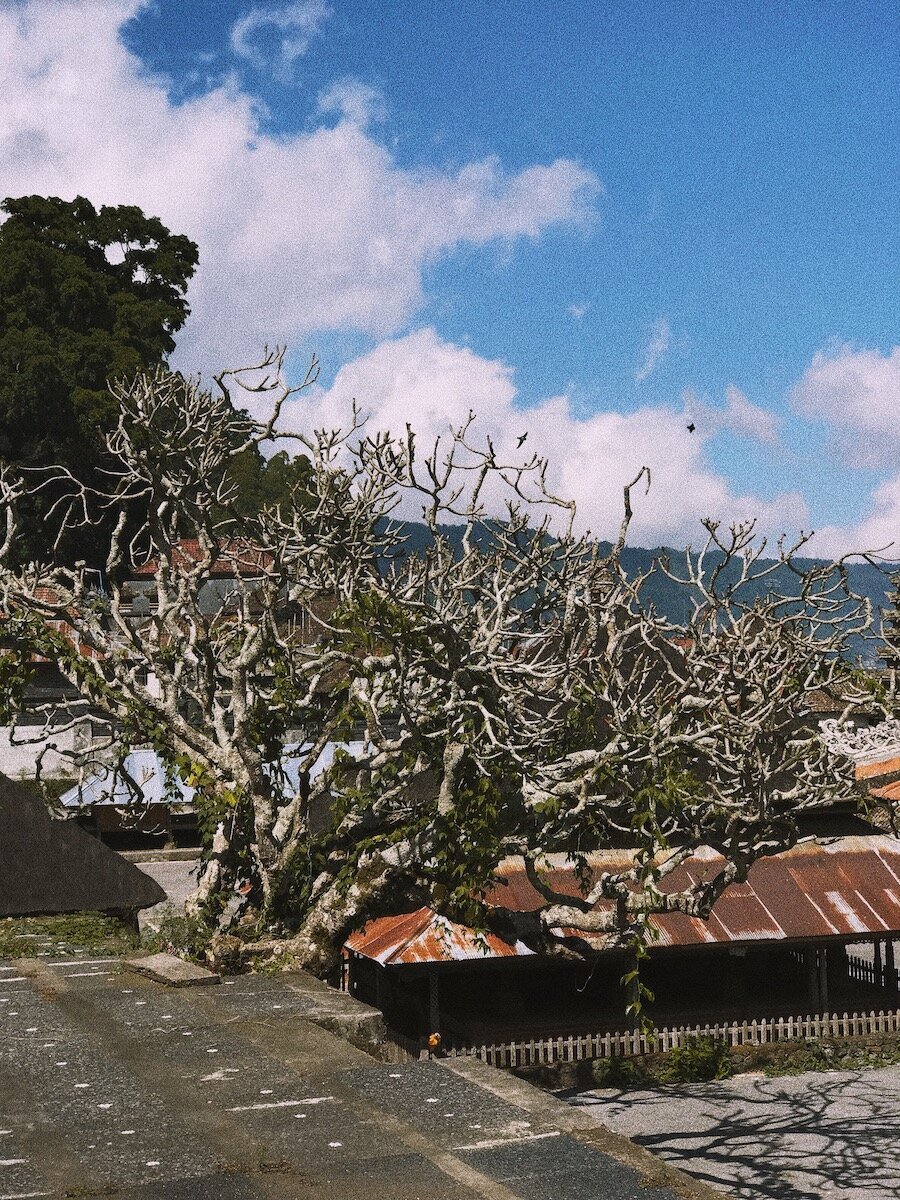Death and Birth Rituals in Indigenous Bali
For my birthday, we set off for an adventure I'd been dreaming of for years.
When I first came to Bali in 2016, I heard of a small village nestled in the mountains, across a lake and only accessible by boat, where a mystical tree stood, under which the villagers kept their dead. The BBC had even written about it in an article titled, 'The Bali village with a magic tree.'
Unlike the rest of Bali, where cremation is customary (and the Balinese are known for extravagant and gorgeous cremation ceremonies), this was one of the last remaining villages of the indigenous Balinese, the Bali Mula, which still holds an ancient burial system rooted in ancestral custom.
The Bali Mula are the native Balinese that fled to the mountains to protect their way of life when the Javanese Majapahit empire colonized the island.
Death has been a major initiatrix in my spiritual journey. It was the illness and unexpected death of my father that took me through my first shamanic descent when I was 22. A portal opened, magnetizing me beyond control into my own death/rebirth, that went on for years and propelled me into my true spiritual path and deep personal transformation.
And last year, when a friend who was like a brother and a part of my heart, suddenly died, I began free-falling down the death/rebirth canal again, down into the unexplored depths of the Underworld.
Death has been with me so much this past year, and it felt initiatory and nourishing to go visit this ancient burial site on my birthday.
Surprisingly, and synchronistically, the day before, we were led to another Bali Mula village, where placentas are ritually sanctified and hung in trees.
There was a beautiful mirror effect on our two-day trip, visiting two ancient villages with magical customs around birth and death.
Bayung Gede and the Placenta Forest
From a Womb Shamanism perspective, placenta is sacred and alive. In some traditions, it’s seen as the energetic twin of the baby, or a primordial grandmother — a companion and protector overseeing the baby’s growth and arrival into the world.
So I was delighted to discover Bayung Gede, where babies’ placentas are ritually washed and hung in a grove of bubak trees, sealed in coconuts.
As we rolled in to Bayung Gede (which means ‘Great Strength’), I felt enchanted by the tranquil and gorgeous gardens leading to the main gate.
The placenta grove felt like a magical place. Quiet, dense, a bit eerie. Walking through the bubak trees, I thought about all the babies that had been born in the village.
Here, the placenta is seen as the spiritual sibling of the baby, and according to a custom practiced for centuries and still preserved in this native village, after the birth, the father brings the placenta to the bubak forest.
Across indigenous and earth-based cultures, connecting the placenta to the earth, through burial and ritual, is a way of anchoring the bond between the baby and the soul of earth, connecting both energetically, and informing mother earth of the baby's arrival, so she may get to know him or her, and his/her unique soul path and energy signature.
There is something immensely powerful to going to these ancestral places and fully feeling what's there with our hearts and bodies. We can receive these amazing frequencies of our ancestors, and the consciousness they lived in.
I feel that they didn't just do things differently, like practicing more rituals and ceremonies, they perceived the world differently. The doorways of perceptions within their minds were open, the magical pathways in their body were flowing with ease.
These ancestors aren't separate from us, they are within us, and we can all remember the pieces that we are here to rebirth for these times.
Ancient Burials and a Mystical Tree in Trunyan Village
On the morning of my 29th birthday, we took a small blue boat to Trunyan village. Surrounded by the peaceful mountains and under the watchful eye of Mount Batur, one of the two volcanoes on the island, we traversed the waters of the lake.
I felt the spirit of Dewi Danu, the lake goddess. As we were gliding over her body, I felt the serenity and excitement of being on the kind of spiritual adventure that makes my heart sing.
We had spent the previous day exploring the region, asking around to find someone who knew of Trunyan and could take us there. And eventually, and it felt meant to be, we met someone who knew someone, who knew someone, who could take us there, a local Trunyanese man called Wayan.
Wayan first brought us to the village. As we stepped off the boat, we found ourselves in perhaps the poorest village we'd ever been to in Bali. I felt both awkward, coming in as a Westerner with my iPhone and all of my curiosity, and incredibly lucky to be let in to this ancient community and the beauty and gifts they were open to share. I felt humbled by the simple groundedness of the villagers that hung around the lake shores, and imagined what life must be like in such an isolated place.
We first visited the village temple, which according to Wayan, is as old as the village itself, about 1,200 years. In the heart of the temple is a 'miraculous' statue, a statue that wasn't carved by man but appeared on its own at the dawn of time, and miraculously, keeps growing year after year! The statue is believed to be an embodiment of the volcano god, and is so fertile, that it actually bore a child!
Foreigners aren't allowed to see it, and actually, the only ones who are allowed to directly look at the statue and care for it are the village's virgins. Each October, on a full moon and during a coming-of-age ritual, the village's teenagers celebrate the statue with a ceremonial primal dance.
The temple looked mostly empty now, and a large group of swallows had made their home under one of the roofs. They flew around in circles around a naked white-barked tree, which felt like such a poetic scene.
Soon, we took the boat again to go further down the coast, to the cemetery. There, stood the massive and magnificent Banyan tree after which the village is named (Trunyan means 'nice-smelling tree'). Local folklore says that it was this irresistibly fragrant tree that drew the water goddess Dewi Danu to come down from heaven and embody into the lake and primeval waters of the island.
Beyond the gate is the unusual graveyard. Most visible and uncanny is a wall of ancestral skulls, which reminded me of the finite nature of human life, and the sameness that underlies all of our appearances and experiences.
There are 11 spots, reserved for those who died of natural causes and were married. Bodies are left 'in the open,' under the protection of triangular bamboo enclosures.
When someone dies in the village, they're brought here. Women aren't allowed to join funeral rites, for, it is believed that women can cause natural disasters, like an earthquake or volcanic eruption!
Each person is decorated with beautiful clothes and their favorite personal belongings, along with photos and offerings.
We walked along the bamboo graves, faces and feet exposed at various stages of decay — an experience that felt both surreal and simple, human.
When a 12th person is brought, the oldest body is removed. The skull is added to the wall, and, most surprisingly to me, the body goes onto a large pile. So there, in the small space of the graveyard, was a big pile of various human bones, blended in with the offerings and personal objects that once were with their owner.
There were many paradoxes to this whimsical, sobering place. Its mysteries are better experienced directly, and so, I'll let you discover its secrets, if you feel called to travel there.
The burial custom found in Trunyan is connected to older open burial systems, which date back to prehistoric times — as found by recent ethnoarchaeological research in North Bali. Many ancient cultures have or had elaborate death and funeral rituals to help the soul's return, and as a living connection to Spirit world and ancestors. A conscious relationship to death also helps undertake the psychic and soulful deaths and rebirths we all experience within one lifetime.
Being in Trunyan was filled with a strange simplicity, a strange beauty. I felt the closeness of this small community, and the humbling beauty of human life.
Being there also brought up this feeling that, as a collective, it seems we’ve come full circle, and we're returning to our roots as a humanity, returning to our earth and to each other.








